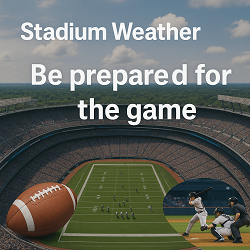Myrtle Beach, SC Weather Forecast and Current Conditions (29572)
Current Conditions From Nearby Local Station

Feels Like 76°F
at
Current Conditions From Nearby Local Station

Feels Like 76°F
at
Point Forecast at a Glance







This Date in Weather History
1871 - Prolonged drought and dessicating winds led to the great Chicago fire, the Peshtigo horror, and the Michigan fire holocaust. Fire destroyed more than seventeen thousand buildings killing more than 200 persons in the city of Chicago, while a fire consumed the town of Peshtigo WI killing more than 1100 persons. In Wisconsin, a million acres of land were burned, and in Michigan, 2.5 million acres were burned killing 200 persons. "Tornadoes of fire" generated by intense heat caused houses to explode in fire, and burned to death scores of persons seeking refuge in open fields.
More on this and other weather history
Myrtle Beach 7 Day Weather Forecast Details
Wednesday Oct 8

Day: Patchy fog before 9am, then a slight chance of showers and thunderstorms between 2pm and 3pm, then a chance of showers and thunderstorms between 3pm and 5pm, then a chance of showers and thunderstorms. Mostly sunny, with a high near 80. South wind 2 to 7 mph. Chance of precipitation is 40%. New rainfall amounts less than a tenth of an inch possible.

Night: A chance of showers and thunderstorms before 11pm, then a chance of showers and thunderstorms between 11pm and 1am, then a slight chance of showers and thunderstorms between 1am and 3am. Mostly cloudy, with a low around 63. East wind 3 to 17 mph, with gusts as high as 25 mph. Chance of precipitation is 40%. New rainfall amounts less than a tenth of an inch possible.
Thursday Oct 9

Day: Partly sunny, with a high near 72. Northeast wind around 17 mph, with gusts as high as 25 mph.

Night: Mostly cloudy, with a low around 60. Northeast wind around 20 mph, with gusts as high as 28 mph.
Friday Oct 10

Day: A slight chance of rain showers after 2pm. Mostly cloudy, with a high near 72. Chance of precipitation is 20%. New rainfall amounts less than a tenth of an inch possible.

Night: A chance of rain showers. Mostly cloudy, with a low around 64. Chance of precipitation is 30%.
Saturday Oct 11

Day: A chance of rain showers. Mostly cloudy, with a high near 72. Chance of precipitation is 40%.

Night: A chance of rain showers. Mostly cloudy, with a low around 63. Chance of precipitation is 30%.
Sunday Oct 12

Day: A slight chance of rain showers. Mostly sunny, with a high near 73.

Night: A slight chance of rain showers before 8pm. Mostly clear, with a low around 60.
Monday Oct 13

Day: Sunny, with a high near 74.

Night: Mostly clear, with a low around 61.
Tuesday Oct 14

Day: Sunny, with a high near 74.
Sun & Moon Monthly
Sunrise 7:16 AM
Sunset 6:52 PM
Last Light 7:17 PM
Moonset 8:49 AM

Close Tide Stations
Myrtle Beach, Combination Bridge
(2.6 miles away)
Springmaid Pier, Myrtle beach
(3 miles away)
North Myrtle Beach, ICWW
(6.8 miles away)
Weather Near Myrtle Beach
Contiguous United States Extremes
Tue's High Temperature
100 at Rio Grande Village, TX and 5 Miles South Of Yuma, AZ and 6 Miles West Southwest Of Glamis, CA and ~
Tue's Low Temperature
14 at Lyman, WY
Weather Folklore
Clouds on the setting sun's brow indicate rain.
Current subscribers - login to your ClearSky account
About Myrtle Beach, South Carolina
Myrtle Beach is a resort city on the East Coast of the United States in Horry County, South Carolina. It is located in the center of a long and continuous 60-mile (97 km) stretch of beach known as the "Grand Strand” in the northeastern part of the state. Its year-round population was 35,682 as of the 2020 census, making it the 13th-most populous city in South Carolina.
Myrtle Beach is one of the major centers of tourism in South Carolina and the United States. The city's warm subtropical climate, miles of beaches, 86 golf courses, and 1,800 restaurants attract over 20 million visitors each year, making Myrtle Beach one of the most visited destinations in the country.
Located along the historic King's Highway (modern day U.S. Route 17), the region was once home to the Waccamaw people. During the colonial period, the Whither family settled in the area, and a prominent local waterway, Wither's Swash, is named in their honor. Originally called alternately "New Town" or "Withers", the area was targeted for development as a resort community by Franklin Burroughs, whose sons completed a railroad to the beach and the first inn, Seaside Inn. His widow named the new community Myrtle Beach after the local wax-myrtle shrubs.
The Myrtle Beach Metro Area is one of the fastest growing metropolitan areas in the country, with an estimated population of 397,478 in 2023. More than 104,000 people moved to the area over eight years, representing a nearly 28% growth in population.
Content from Wikipedia, licensed under CC BY-SA 3.0.
How We Provide Better Local Weather
Current conditions: We use the nearest available station to your location - including professional MESONET/MADIS and local weather stations - often miles closer than regional airports.
Forecasts: National Weather Service point forecasts predict for your specific area, not broad regional zones, making them far more relevant to your location.

